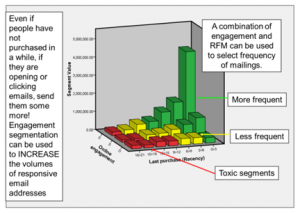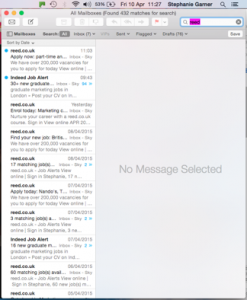Apr
2015
Email marketing frequency: Engaging or alienating customers?
Frequency of sending emails is an important part of building customer relationships: too many might irritate and too few could lose the recipient’s interest (Ellis-Chadwick & Doherty, 2012). This fine line is hard for emarketers to comprehend.
Relationships between customers are crucial for companies to maintain, as its all about trust. However, the amount of emails a company sends can cause customers to become dissatisfied, leading to a break in trust and relationship.
I signed up to Reed a couple of months ago to assist on my graduate job search. But since signing-up I receive what seems like endless emails from them. From the picture below you can see that I receive 1 email a day, without fail! The reason I haven’t unsubscribed is because I’m hoping that one day an email will prove relevant and beneficial to me.
However, this does not take away from the fact that I find the frequency of these emails extremely irritating. Moth (2014) argues that it’s not about sending more or less emails to customers, its about sending the right amount of emails to the right people. But, how much is too much?
HubSpot proposes a 5-step test to determine optimal email frequency specifically for an individual company, detailed below and more information is provided in the embedded link
1.) Establish a hypotheses
2.) Choose a list segment
3.) Establish baseline metrics
4.) Create and schedule test emails
5.) Measure and analyse results
There is a lot of research, both practitioner and academic, surrounding email frequency to sustain and maintain the relationship between customers and businesses. From a practitioner perspective, Alchemy Worx (2013) states that 60% of customers received less than 6 emails per day from trusted brands, of which 40% received 3 or less. However too much frequency can cause customers to unsubscribe (image below) (Moth, 2014). Mail Chimp (2013), further supports this fact, by stating that if ‘frequency goes up, engagement goes down’.
However, Moth (2014) suggests that email frequency should be based upon online engagement and purchase history. Reinforcing that its about sending the right amount of emails to the right people, as depicted in the image below.

Ellis-Chadwick and Doherty (2012) conducted a study into email marketing, where an electronic archive was set up to ensure that all the emails were stored in a consistent and secure manner. Over this period, 20 retailers posted nearly 1,000 separate emails, with the most active retailer sending 113 messages, which equates to one email every 5 days, on average.
Mohammadi, Malekian, Nosrati, & Karimi (2013) suggest that businesses should email customers in a 3 pronged way. Firstly, an email should immediately follow-up after a behaviour trigger or customer action, accompanied with a good customer service tone. I found an example of this in my emails just the other day. It came after I began signing up for a gym membership, and then decided to leave the page. 20 minutes after I then received a follow-up email, which then prompted me to complete my membership registration.
Mohammadi, Malekian, Nosrati, & Karimi (2013) suggest that for the 2nd and 3rd follow-up these should come a day or 2 after, and in a weeks time. These automated trigger emails help remain businesses focused on building relationships over time.
Although there are differences in opinion regarding recommended email frequency, Moth (2014) suggests that the businesses need to segment their audience, and to test sending messages (through open and clickthrough rates) so that messages are tailored to customer behaviour, to ensure relationships are maintained without alienating customers .
Hynek (2014) reportedly has found the ‘sweet spot’ for the ideal frequency to engage customers. Sending an email every 2 weeks is the frequency best received by customers, without ‘burning out’ subscriber lists or alienating customers.
However, all of this being said, it is more acceptable to increase email frequency in the lead-up to Christmas periods (Charlton, 2013).
References
Alchemy Worx (2013) Debunking the 7 myths of email marketing – Infographic [Online] <http://www.alchemyworx.com/emailworx/2013/strategy/subject-lines/debunking-the-7-myths-of-email-marketing-–-infographic> [accessed 1 March 2015]
Charlton, G. (2013) 30+ christmas email marketing tips from the experts. Econsultancy [Online] <https://econsultancy.com/blog/63714-30-christmas-email-marketing-tips-from-the-experts> [accessed 9 April 2015]
Ellis-Chadwick, F., & Doherty, N. F. (2012) Web advertising: The role of e-mail marketing. Journal of Business Research. Vol. 65, No. 6, p843-848
Eridon, C. (2011) The 5-step test to determine optimal email frequency. Hub Spot [Online] <http://blog.hubspot.com/blog/tabid/6307/bid/30302/The-5-Step-Test-to-Determine-Optimal-Email-Frequency.aspx> [accessed 10 April 2015]
Hynek, A. (2014) The ideal email frequency. Campaign Monitor [Online] <https://www.campaignmonitor.com/blog/post/4154/the-ideal-email-frequency> [accessed 9 April 2015]
Mail Chimp (2013) Sending frequency: More is not always better! [Online] < http://blog.mailchimp.com/sending-frequency-more-is-not-always-better/> [accessed 9 April 2015]
Mohammadi, M., Malekian, K., Nosrati, M., & Karimi, R. (2013). Email Marketing as a Popular Type of Small Business Advertisement: A Short Review. Australian Journal of Basic and Applied Sciences. Vol. 7 (Issue 4), p786-790
Moth, D. (2014) Email frequency: How much is too much? Econsultancy [Online] <https://econsultancy.com/blog/64165-email-frequency-how-much-is-too-much/> [accessed 9 April 2015]




